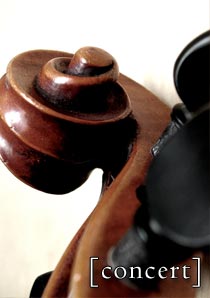The Stars Are Not Aligned
| Year Composed: | 2019 |
| Instrumentation: | perc solo + 2.2.2.2/4.3.3.1/timp+2 perc/hp/strings |
| Duration | 22 minutes |
| 1. | Bound to Earth |
| 2. | Flowing with the Earth |
| 3. | Mourning the Earth |
Program Notes
During the summer of 2017 I was approached by percussionist Michelle Colton, my colleague and friend of thirteen years, with the idea of creating a concerto that would transcend historical and stylistic boundaries. A composer herself, Michelle related to me her experience of being delayed on a long train trip, which caused her imagination to wander; she envisioned an unconventional tapestry of sonic colours, consisting of non-Western instruments paired with timbral evocations of the natural world (ocean drums, pouring water, sticks and stones, vocals.) Intrigued and moved by these aural images, I had a fleeting vision of a work in which environmental themes - including the looming crisis of climate change - could be expressed through musical metaphor.
The resulting concerto frames the soloist as an ambassador of nature, while the orchestra represents human culture and civilization. The title, The Stars Are Not Aligned, is an intentional negation of the common phrase "the stars are aligned." It questions the idea that "everything happens for a reason" - in other words, that fate, God, or destiny conspire to design purpose for human beings. Despite my actual disposition toward the mysteries of life - which is on the whole optimistic and occasionally even spiritual - it was important for me to grapple with the existentialist claim that the world is devoid of external meaning, as I believe such claim has direct bearing on the themes being explored in this work. Far from being an endorsement of hopelessness, The Stars Are Not Aligned can be read both philosophically and musically as a call to action: faith in the stars will not preserve our planet, nor reduce the suffering caused by our actions. We alone are responsible for both the preservation of life and the cultivation of balance with our home.
The first movement, "Bound to Earth," is a musical portrait of Eden, where humanity and nature are bound to one another in perfect unity. Following the orchestra's opening chord - a 'primordial' sonority centred on D - the soloist enters with an extended passage on the glass armonica, whose silvery, nocturnal tones are meant to evoke the music of pre-dawn. Orchestral surges, privileging perfect fifth intervals and the 'bent' notes of the acoustic overtone series, are followed by a more animated passage for steel pans, while the musicians hum gentle drones in support - a metaphor for the 'Oneness' of humankind and nature. The movement ends with an unsettling chord comprised of stacked tritones, anticipating the twelve-tone clusters to follow, signifying the emergence of human consciousness - and with it, its capacity for both creativity and destruction.
The second movement, "Flowing with the Earth," is the most overtly traditional of the three movements. The soloist, playing the marimba for the entirety of the movement, engages in a dynamic dialogue with the orchestra that deliberately recalls the great European concerti of the 19th and 20th centuries. The movement represents a utopian vision of sorts: a world in which civilization and nature coexist in a kind of harmonious 'flow' state in which order and chaos are perfectly balanced. A rhythmic motive in 7/8 is passed from marimba to orchestra and back again, culminating in a lyrical mid-section reminiscent of the 'epic' Hollywood film score - an explicit symbol of the ascendancy of human culture. As the movement continues, however, this state of flow is disrupted, and the balance begins to shift dangerously in favour of the orchestra. The tritone pillars from the previous movement - harmonically dissonant and rhythmically off-kilter - return with a vengeance, attacking the soloist at every turn. By the end, the soloist - disoriented, frantic, and exhausted - is metaphorically 'killed' by the orchestra.
The third movement, "Mourning the Earth," evokes a bleak and at times hellish landscape. In an attempt to imagine, musically, what a world without greenery might sound like, I have attempted to leach the music of certain 'primary' colours; hence, melodic motion is abandoned (save for a ghostly solo appearance by the bassoon midway through the movement), triads are 'polluted' by microtonal inflections, and instrumental timbres are distorted beyond recognition. The soloist, meanwhile, undergoes a transformation from benign spirit into a terrifying force of nature. The movement's brief but fiery climax is an evocation of Nature unleashed, in the form of an orchestral tsunami propelled forward by a battery of Chinese drums. The piece ends in dubious triumph, on a chord that oscillates between D major and D minor, followed by a massive tone cluster that quickly evaporates until only a single D is left suspended in mid-air by the glass armonica, as if for eternity.
Commissions and Awards
- Commissioned by Michelle Colton, with generous assistance from the Canada Council for the Arts.
Performances
- May 22, 2022 - Michelle Colton, percussion; Niagara Symphony Orchestra, conducted by Bradley Thachuk. First Ontario Performing Arts Centre, St. Catharines, ON

